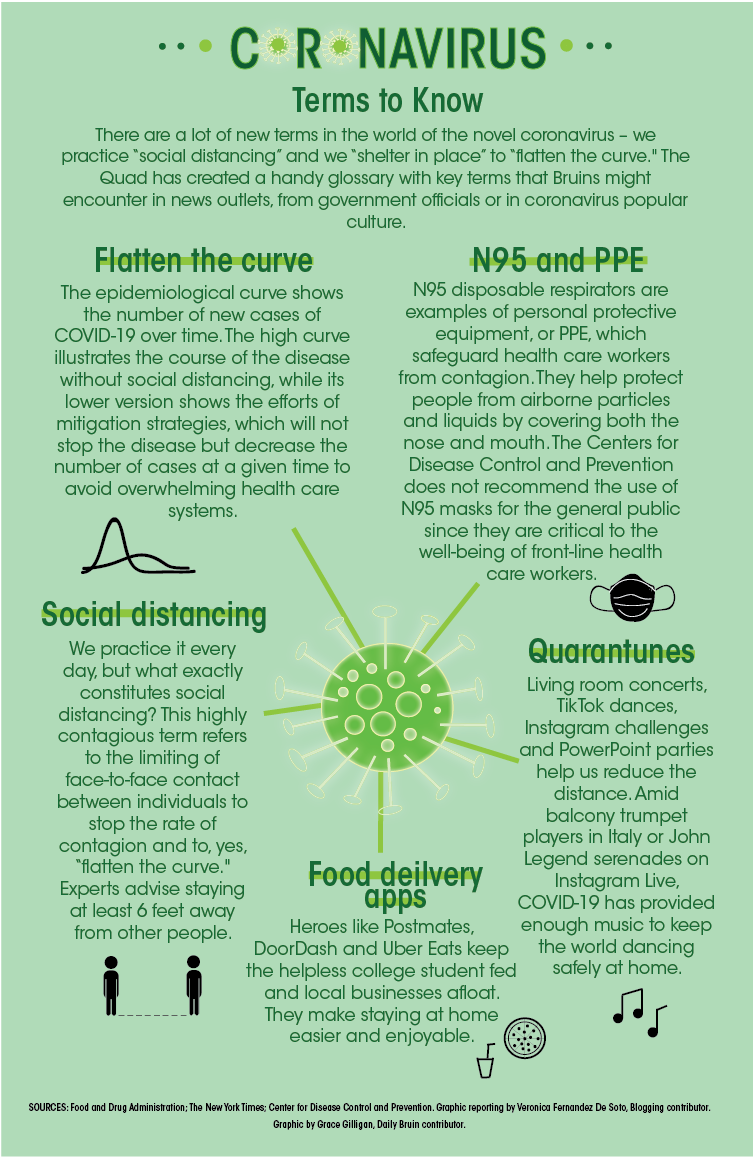The Quad: A breakdown of the most common terms used during the COVID-19 pandemic

(Grace Gilligan/Daily Bruin)

By Veronica Fernandez De Soto
April 20, 2020 2:26 p.m.
The novel coronavirus has unleashed a novel vocabulary.
World War I left us with words like “trench coat” and “no man’s land,” while the rise of internet speak brought on the “meme” and Twitter linguists. Likewise, the coronavirus pandemic has adjusted the way we speak.
Language is in constant flux: It must adjust to encompass, explain and articulate unprecedented events, which is why in the world of the “novel coronavirus” we practice “social distancing” in order to “flatten the curve.” Even though these terms have become ubiquitous parts of our everyday life, a couple of months ago they were as foreign as their real-life consequences.
Public officials, medical providers, news outlets and even our idle aunts on Facebook are all using these new or repurposed terms to communicate during these confusing times. The Quad has collected some of the most abundant terms to help any head-scratching Bruins.
One Virus, Many Many Names
There are many ways we have decided to refer to the same virus. To begin, the official scientific name of the virus causing the pandemic is SARS-CoV-2. This denomination itself is an acronym, which stands for severe acute respiratory syndrome coronavirus 2.
COVID-19 is the name given to the disease caused by SARS-CoV-2. Also an acronym, COVID-19 is short for Coronavirus Disease 2019.
The term coronavirus is not new or specific to the current pandemic. It refers to a family of viruses that cause many different kinds of diseases including the common cold. Not to be confused with the beer, the viruses get their name because of their appearance under a microscope, which shows the virus surrounding by spikes similar to a crown, or a “corona” in Latin.
Ironically, the term novel coronavirus is actually out-of-date. It was the initial name given to the virus before scientists discovered the specific strand causing the disease, which as you already know is SARS-CoV-2.
Pandemic, Epidemic, Outbreak
Many of these new ways of speaking we owe to epidemiology, which is the scientific branch focusing on the distribution, causes and risk factors of health-related events in specific populations.
Epidemiologists study the different levels and classifications of a disease. COVID-19 was first understood as an epidemic by the World Health Organization (WHO) when it began surfacing in December 2019 in Wuhan, China. This term is reserved for an increase of an unexpected disease that affects a specific region. Outbreak is often used interchangeably with epidemic; however, it is reserved for diseases affecting a smaller region.
A pandemic is the spread of an unexpected disease worldwide. On March 11, the WHO officially classified COVID-19 as a pandemic after its spread reached 100 countries. The last pandemic was declared in 2009 because of the emergence of a new strand of influenza A, H1N1.
Call it what you want, but stay home
In labeling COVID-19 a pandemic, public health officials had to devise strategies for containment. This refers to the actions taken to keep an infectious disease from spreading from a small group to the larger community. Containment strategies have been carried out including travel bans, contact tracing, and mandated self-isolation and self-quarantine. Contact tracing refers to the way officials identify infected individuals and trace everyone they came into contact with, asking these individuals to self-quarantine, or stay at home for a designated period.
Most self-isolation measures for COVID-19 last about two weeks. According to the Centers for Disease Control and Prevention, this is the incubation period, or the time it takes for symptoms to appear after a person has been infected.
Once the virus has spread considerably, the public health strategy turns toward mitigation. This is when public health officials turn to the population to stop the spread of the disease. Perhaps the most abundant and innovative term to originate from the current pandemic is social distancing – a mitigation measure used to increase the space between people to slow the spread of the virus. In current official terms, this means standing at least 6 feet from one another.
Individual states have also brought forth their specific methods of mitigation. These are often referred to as stay-at-home or shelter-in-place orders. These measures order residents to stay home except for essential activities such as buying food, medical supplies, etc. There are generally very few differences between these orders; it’s just semantics at play. The distinction began when New York Governor Andrew Cuomo refused to call the order he was enforcing a “shelter-in-place” order because he believed the term inspired panic.
These strategies change the world we live in, including canceling schools, closing businesses, mass events, etc. However, if successful they will help flatten the curve.
The curve we have heard so much about refers to the function of daily cases and the days since the first case. The usual graph shows two curves: a higher curve, which shows the spread of the disease over time without any mitigation strategies, and a flatter curve displaying the disease’s course with mitigation strategies. The idea behind flattening the curve is not to extinguish the disease but instead to reduce the number of individuals affected by the disease in a period of time, preventing the overflow of patients overwhelming health care systems.
Flattening the curve will ultimately help protect the front-line health care workers, who provide direct health care services to communities. These nurses, doctors, community health workers, pharmacists and more are usually the first point of contact between an individual and the system. Presently, there has been a lot of criticism that front-line workers in the U.S. are not receiving adequate personal protective equipment, or PPE, which includes masks, gloves, goggles, and gowns to properly protect their own health. Among this equipment, N95 masks have also been lacking. These are disposable respirators, which cover both the nose and the mouth and keep airborne particles away from the user.
Getting Through This Together
The COVID-19 pandemic has created a new reality for people around the world, including but definitely not limited to the creation of new popular culture terms. Some of them attempt to make light of an overwhelming situation, while others surface from changes in work or education. All of them, however, serve as a reminder that people continue to live their lives.
Remote learning and working measures have seen a rise in the use of video conference software such as Zoom. With this, there has been a rise in related slang. Zoombombing episodes of individuals disturbing a class or gathering on Zoom have popularized the phrase. Similarly, as gyms close down, the term Zoom Yoga has emerged – The Verge even called Zoom “2020’s hottest yoga studio.”
More time at home has also resulted in new challenges, hobbies and pastimes. TikTok, an app used mainly by teens, seems to be expanding its reaches to a wider age range to provide homebound people with immediate entertainment. Many of us have had to painfully watch our distant family members attempt the flip-the-switch challenge, or dance to the “quarantunes” of Doja Cat.
It does not seem as though the creation of new terms and ideas will cease anytime soon, as life in a pandemic engenders innovations and transformations.
It turns out that even at 6 feet apart, we find new ways to communicate.

